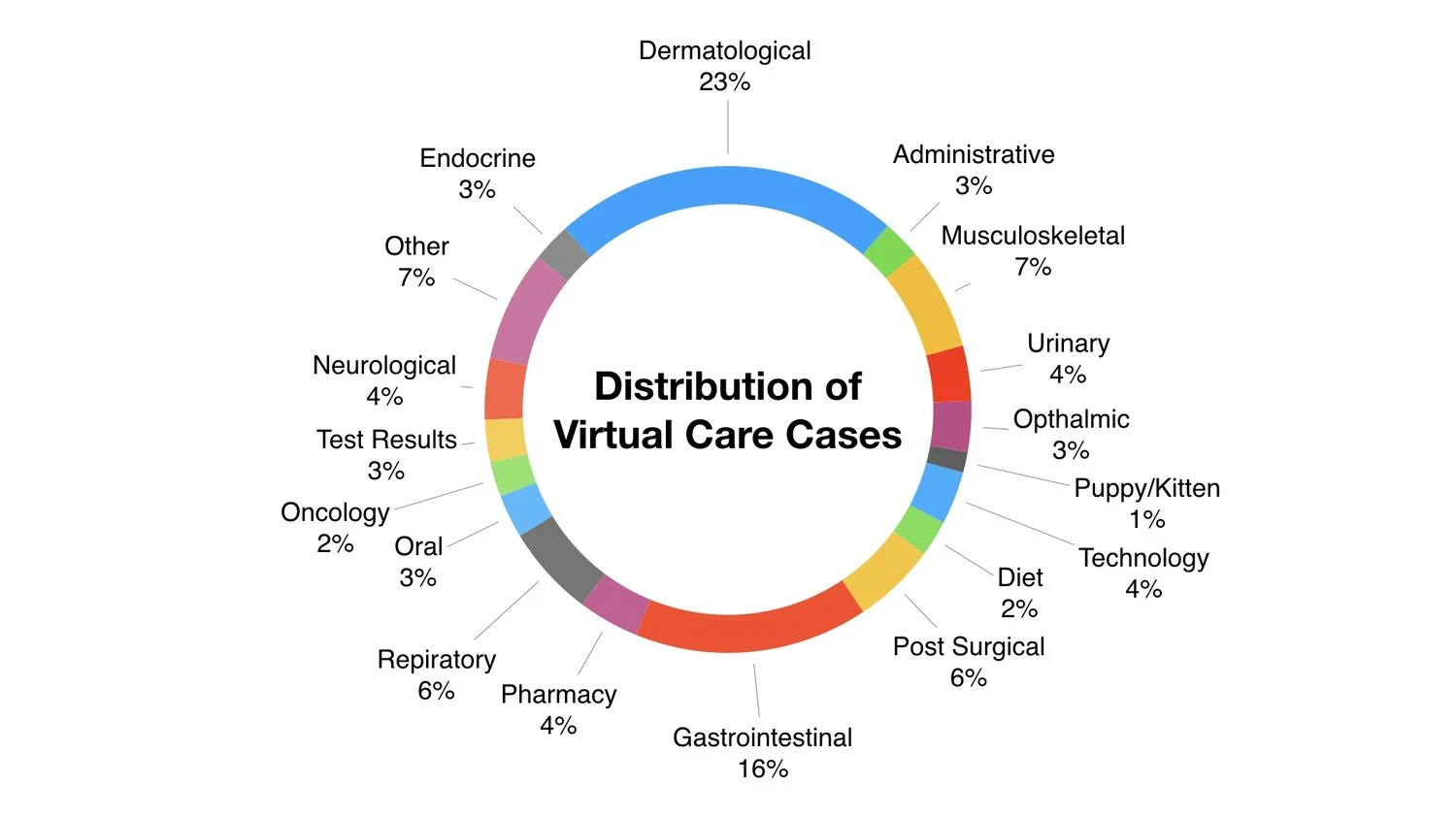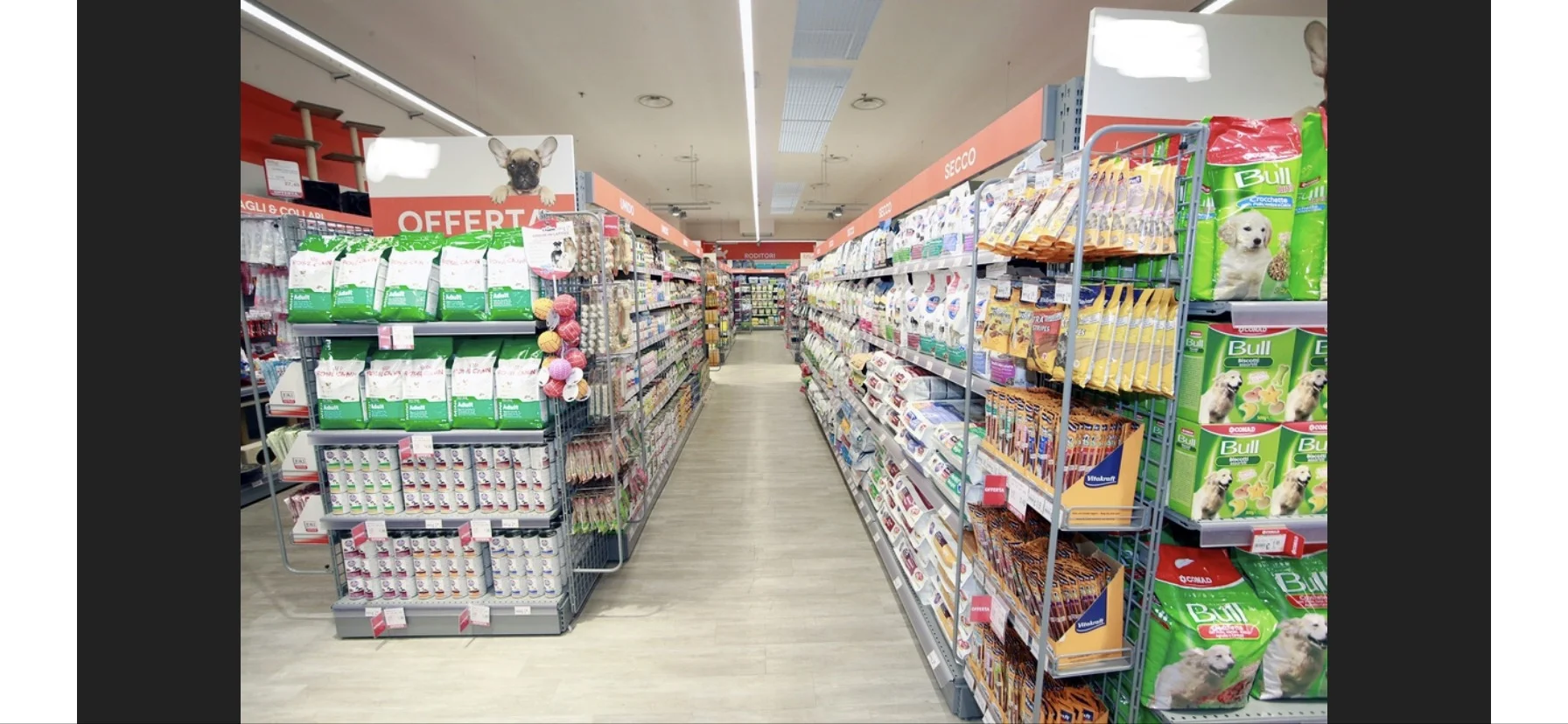Distribution of 1300 Virtual Care Cases
/Almost 40% of our virtual care cases involve the skin or the gut.
Real life virtual care.
Almost 40% of our virtual care cases involve the skin or the gut.

Many veterinarians are concerned that the addition of telemedicine to their practice will increase their professional liability. This concern is valid, but only for the small number of doctors who are not currently offering telemedicine. Most veterinarians utilize telemedicine every day via the telephone and can decrease their professional liability by integrating modern telemedicine technology.
AVMA defines telemedicine as “the use of a tool to exchange medical information electronically from one site to another to improve a patient’s clinical health status”. Therefore, a telephone call, email, text message, etc to a client with a valid VCPR constitutes telemedicine. Not all practitioners realize how frequently they use telemedicine. This oversight increases the risk of complacency and delays the modernization of telemedicine tools, resulting in more risk for the practice.
The telephone is still a valuable telemedicine technology, but it is dependent on the expertise of the person who is remotely describing the problem. For example, a first time dog owner will probably not be able to describe a problem about his dog as well as a third generation dairy farmer will be able to describe a problem with her cow. Modern telemedicine technology (photos, videos, live chat) allows the veterinarian to get accurate data regardless of the expertise of the owner, therefore reducing the risk of remote care.
It is important to note that modern telemedicine tools do not mandate that all problems are solved remotely. Some veterinarians are concerned if they incorporate modern telemedicine tools, clients will expect every problem to be solved virtually. This is incorrect. Clients are contacting the veterinarian, regardless of technology (telephone or SnapChat) because they want expert advise on what the next best decision is for their animal.
Medici is an intuitive app and this video shows how easy it is to invite a client onto the platform.
My first two jobs out of veterinary school were equine ambulatory and a mixed large animal practice that served the Amish community. Some of my most memorable and miserable stories happened while I was practicing after-hours. I remember the
Read MoreI integrated virtual care into the practice without reducing my in-clinic availability because almost all of my virtual exams are done via texting through a secure app.
There is a perception that virtual care is synonyms with live video conference. People mistakenly think that virtual care cases require a scheduled time when the doctor and the client sit in front of a computer screen and discuss a problem about the pet.
This type of virtual care is valuable (feline house soiling) but is not feasible for most veterinary practices because the doctor has to block-off in-clinic time to see virtual patients. Thankfully fewer than 5% of my virtual cases require a video conference.
Most of my cases are solved with texting. I recently was in a text conversation with a client via Medici about her dog and I was concerned that she was confused about my medical instructions. I decided that I needed to offer her a phone call to clarify, even though I knew it would be less time efficient. To my surprise, she declined the offer of a phone call and wanted to continue texting. We passed a few more clarifying texts back and forth and the exam was finished. She was happy and I was amazed.
Virtual care is an easy addition to any veterinary practice because most problems can be solved via text. What I have discovered is that most clients, even older “nontechie“, clients prefer text messaging. This is good news because it frees me up to practice virtual care without reducing my in-clinic availability.

Some of my best clients don’t have a lot of extra money. They love their pets and take wonderful care of them but can’t always afford an in-clinic exam due to financial constraints.
Read MoreVeterinarians commonly ask me how much time I add to my work day by offering virtual care. My experience has been that virtual care actually saves me time.
I save time because I rarely have to call owners who are connected to me on Medici. I don’t have to play phone tag to discuss results or answer the client questions that require a doctor.
I also save time because I can send an asynchronous text message during my workday. I incorporate virtual care into my normal workflow without additional time blocked off in my schedule. The beauty of text message communication is that clients do not get upset if I don’t immediatly respond because texts are asynchronous.
Acceptance of asynchronous communication is not unique to the veterinary space. Think about how you text your friends and family. You might text them back immediately or it could be a few hours. Sometimes you are texting back-and-forth and there is a long pause in the conversation without warning. It might seem like it would make everyone frustrated but culturally we just accept this as the normal rythum of text communication.
I have found my clients follow the same cultural norms and don’t get upset if our conversation is paused when I step into an exam room or do not respond immediatly.
For added customer service Medici helps me set my client’s expectation about the length typical response by posting it at the top of each conversation.

We invite our puppy and kitten owners onto our virtual care platform and have them pay a single fee for unlimited texting until their pet is six months old.
I had an eye-opening experience a few months ago when a client sent me a Medici text and picture while he was in the pet food store asking me what bag he should purchase. I had my phone on me and was able to respond in real time and advise him what food I recommend for his pet. He was grateful to have the expert advice and not have to guess or simply rely on the pet store staff for such an important decision.
After this virtual care interaction, I realized that most owners want my advice about pet food but don’t want to hassle with a call that will most likely end up in me having to call them back.
If we start to make access to the veterinarian easier via virtual care our clients will contact us more often and we might regain some of the ground we have lost as the animal’s diet expert.

Ticks carry a lot of disease and owners don’t always know how to identify a tick. Our clients love the convenience, minimal expense, and peace of mind that virtual care gives them. They can take a picture of area of skin in question, send it via Medici, and get a quick response
I recently had a client send me a picture of an area of her dog’s skin that she was concerned might be a tick. After she sent me a couple different views of the area, she was relieved to find out that it was not a tick. 😃👍🏻
Take a look at this testimonial video to see how offering virtual care improved the VCPR in our practice.
The easiest place to start virtual care is with medical rechecks. Diagnose the problem in the exam room and then ask the owner to follow up with a picture and text via Medici.
Read More
The bond we share with our clients and their pets became much stronger when we introduced virtual care because our clients can get in touch with their veterinarian via a quick text message when they have questions about their pets.
As veterinarians, we can offer this service without being inundated with messages because Medic allows us to charge for our consultation and gives us the ability to turn the app on and off. Our clients can clearly see in the app if we are available.
We use virtual care to show owners what we see in their pets during surgery. I have been surprised at how many owners appreciate our capability to send them images of the pathology.
Read More